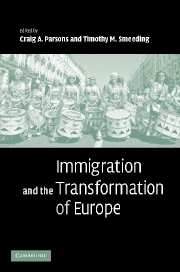Book contents
- Frontmatter
- Contents
- List of figures
- List of tables
- List of contributors
- Acknowledgements
- 1 What's unique about immigration in Europe?
- 2 Europe's immigration challenge in demographic perspective
- 3 Migration into OECD countries 1990–2000
- 4 Divergent patterns in immigrant earnings across European destinations
- 5 Economic consequences of immigration in Europe
- 6 Occupational status of immigrants in cross-national perspective: A multilevel analysis of seventeen Western societies
- 7 Immigrants, unemployment, and Europe's varying welfare regimes
- 8 How different are immigrants? A cross-country and cross-survey analysis of educational achievement
- 9 Immigration, education, and the Turkish second generation in five European nations: A comparative study
- 10 Managing transnational Islam: Muslims and the state in Western Europe
- 11 Migration mobility in European diasporic space
- 12 The new migratory Europe: Towards a proactive immigration policy?
- 13 European immigration in the people's court
- 14 The politics of immigration in France, Britain, and the United States: A transatlantic comparison
- 15 “Useful” Gastarbeiter, burdensome asylum seekers, and the second wave of welfare retrenchment: Exploring the nexus between migration and the welfare state
- 16 The European Union dimension: Supranational integration, free movement of persons, and immigration politics
- 17 The effectiveness of governments’ attempts to control unwanted migration
- Index
- References
13 - European immigration in the people's court
Published online by Cambridge University Press: 23 June 2009
- Frontmatter
- Contents
- List of figures
- List of tables
- List of contributors
- Acknowledgements
- 1 What's unique about immigration in Europe?
- 2 Europe's immigration challenge in demographic perspective
- 3 Migration into OECD countries 1990–2000
- 4 Divergent patterns in immigrant earnings across European destinations
- 5 Economic consequences of immigration in Europe
- 6 Occupational status of immigrants in cross-national perspective: A multilevel analysis of seventeen Western societies
- 7 Immigrants, unemployment, and Europe's varying welfare regimes
- 8 How different are immigrants? A cross-country and cross-survey analysis of educational achievement
- 9 Immigration, education, and the Turkish second generation in five European nations: A comparative study
- 10 Managing transnational Islam: Muslims and the state in Western Europe
- 11 Migration mobility in European diasporic space
- 12 The new migratory Europe: Towards a proactive immigration policy?
- 13 European immigration in the people's court
- 14 The politics of immigration in France, Britain, and the United States: A transatlantic comparison
- 15 “Useful” Gastarbeiter, burdensome asylum seekers, and the second wave of welfare retrenchment: Exploring the nexus between migration and the welfare state
- 16 The European Union dimension: Supranational integration, free movement of persons, and immigration politics
- 17 The effectiveness of governments’ attempts to control unwanted migration
- Index
- References
Summary
Introduction
What is Europe to do about immigration? Mortality is up and fertility is down, resulting in an ageing population and a steadily shrinking workforce in most European countries (United Nations Population Division 2000). Until the invention of robots paying taxes, the policies required to preserve the kind face of European capitalism are either painful or unfeasible. Are Europeans prepared to have more children, work until the age of seventy-five, pay steeper taxes, or accept reduced retirement and health-care benefits? Because immigrants tend to be younger than the native-born populations of European countries and to have larger families, an active immigration policy seems an obvious response to the dictates of demography and economy (Joppke 2002:259). And there is no shortage of people clamoring to get in. Nevertheless, since the 1970s, most European governments have tried to “stem” rather than to “solicit” migrants (Joppke 2002; but see also Freeman 1995).
For all the talk of post-nationalism and globalization among scholars, the movement of people across borders remains less politically acceptable than that of capital or goods. As this chapter will show, among European publics enduring cultural loyalties seemingly trump the economist's rational calculus in which workers are infinitely substitutable. The current phase of European integration is supposed to produce common immigration and asylum rules. Yet most EU leaders have rejected proposals to establish a Union-wide immigration quota as a response to the numbers of workers and refugees eager to get in.
- Type
- Chapter
- Information
- Immigration and the Transformation of Europe , pp. 327 - 361Publisher: Cambridge University PressPrint publication year: 2006
References
- 6
- Cited by



